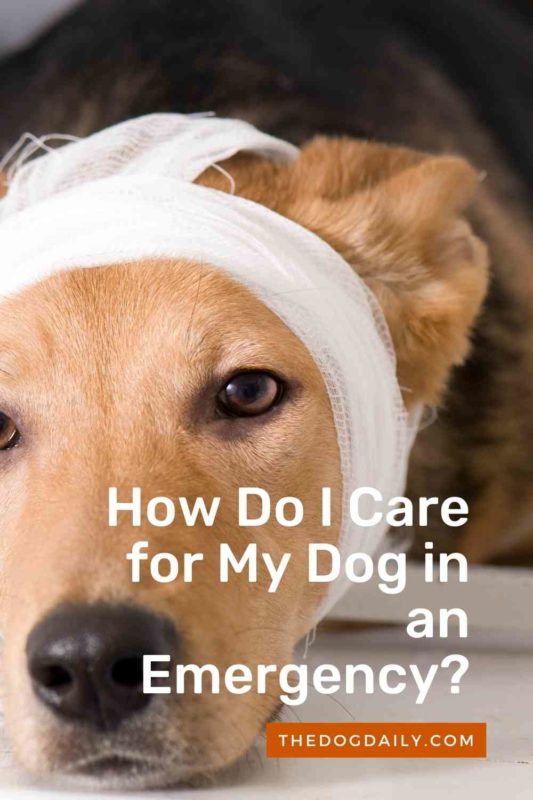Do you Know Dog-first Aid?
Knowing what to do if your dog has a medical emergency can mean the difference between your dog’s life or death. According to the American Animal Hospital Association, one out of every four dogs may be saved if a pet first-aid technique is used before the injured animal arrives at a clinic. However, less than 1 percent of pet owners have a pet first-aid kit or have been trained in first aid, estimates Thom Somes, Pet Tech owner, a company that trains instructors and teaches pet first-aid classes across the country.
How are your first-aid skills? Aside from calling your local pet emergency hospital or contacting your veterinarian, would you know what to do if your dog faced a sudden medical emergency? If you think your first-aid know-how could use some brushing up, you’re not alone.
Pet First-aid Classes
Increasingly, dog owners are taking classes to educate themselves about medical first aid for their treasured pals. The American Red Cross, for example, offers dog first-aid classes at a number of its chapters across the country. At many chapters, you’ll find dog first-aid kits and a dog first-aid book for purchase.
Dogs are so cherished in Carmel, Calif., that the local Red Cross there keeps a stash of dog biscuits in the cookie jar on the front counter. The chapter’s dog first-aid classes are wildly popular, says Sharon Crino, executive director. “We live in an area where pets are like family,” says Crino. “It has been quite a success.”
The American Red Cross and Pet Tech provide a directory for pet first-aid classes on their websites. Courses include management of emergencies involving bleeding, choking, poisoning, and more. Students even practice mouth-to-snout resuscitation on dog mannequins.
Practical Advice for a Dog Emergency
While experts caution that it’s best to receive training in a class, there are basic first-aid practices you can put to use until you complete the training:
-
Assemble or purchase a first-aid kit
You’ll find inexpensive dog first-aid kits online or in pet stores, but Somes recommends assembling your own so that you’ll be familiar with its contents. (The Humane Society of the United States Web site offers a list of items.) Keep a kit at home and in your car. Ensure your kit includes some way to stably transport your dog, such as a blanket you can use as a stretcher. Include vital information in the kit. You’ll want to have your veterinarian’s phone number, poison control numbers, and the number and address for an emergency veterinary service in your area. The American Society for the Prevention of Cruelty to Animals maintains a poison control hotline at 888-426-4435. (The ASPCA may charge you a consultation fee if you receive assistance through the hotline.)
-
Assess the situation
Too often, dog owners react without thinking. “Make sure you have ‘scene safety,'” advises Somes, who calls himself “The Pet Safety Guy.” Don’t rush into the street to check on a dog that has been hit by a car, even if it is your own. Somes tells the story of a dog owner who was almost hit by a car herself as she raced to help her furry friend. “If it’s dangerous or appears dangerous to you, you don’t want to become a victim as well,” says Kevin Cole, who teaches the pet first-aid classes for the Carmel American Red Cross chapter.
-
Anticipate your dog’s behavioral changes
If your dog is sick or injured, it may snap at you. Read its body language first and approach cautiously. Look for ears laid flat, hair standing up on the haunches, or even a glare. Don’t place your face close to your dog’s face to give comfort. Dog first-aid classes teach muzzling techniques using soft fabric, such as a tie or a length of gauze.
-
Secure your dog
Restraint accompanies muzzling, says Somes. “The dog can make the situation worse by moving,” he says. “A dog will run with a broken limb.” It may take two adults to restrain a dog using a towel or blanket gently.
-
Stay calm
Dogs note when your heart rate and breathing accelerate or if your voice escalates in pitch, Somes says. If you can’t be calm, have another adult step in.
-
Don’t call 911
It’s often our first reaction in an emergency, but it won’t help your dog. Unless an animal is endangering people, you’ll get no response.
The best way to prepare for an emergency is to know your healthy dog, says Cole. “Recognize what’s normal in your animal. Then, know how to respond when things aren’t normal.” Finally, understand that first aid doesn’t substitute for veterinary care. First aid is meant to stabilize your dog or alleviate a life-threatening situation before your dog can receive expert medical attention.
Article written by Author: Kim Boatman

